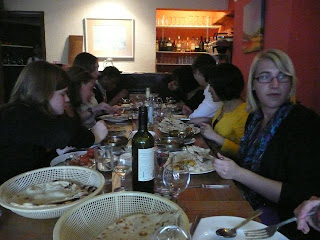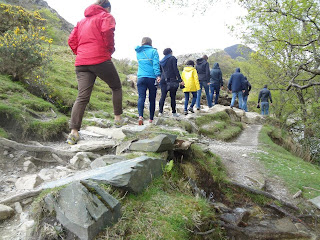After a few days at home preparing the flat for students and catching up with urgent matters, we traveled to London by bus on Monday 30 April, then continued to Heathrow to catch a flight to Prague. Retired Luther colleague, Norma Hervey, had invited us to visit and to stay with her, so we left the students on their own for the week.
 |
| Old Jewish cemetery. |
Norma's flat is ideally located, just at the south edge of the Josefov (the Jewish Quarter), and a short walk from the Old Town Square. As soon as we arrived she took us on a walk-around tour. It was dusk, but we saw the Old Town Square, looked down one end of Wenceslas Square, and cross the Charles Bridge before turning in for the night.
 |
| Old Town Square and Jan Hus memorial. |
The next morning we had breakfast, then headed out on our own to visit the Josefov sites while Norma went to her morning workout. Prague's large Jewish community was nearly wiped out by the Nazis, but several old synagogues and a large cemetery remain behind, most now only as museums. The "Spanish" synagogue, not the oldest but the most ornate, was particularly interesting.
 |
| View of the city from our restaurant. |
We met up with Norma and took the tram to the Castle area. We had lunch at an outdoor restaurant with a spectacular view of the city. Then Norma walked us through the non-ticketed portions of the Castle for orientation, then took us for a walk through the gardens. We walked a very long time on a hot day, but eventually got to a tram and got back to Norma's for a light supper.
 |
| Royal Gardens. |
On Wednesday, Mary and I returned to the Castle, bought a ticket, and did the tour. St. Vitas Cathedral and the 9th century St. Nicholas basilica were major portions, and a highlight was "The Golden Lane," a 12th century residential street inside the Castle wall where Franz Kofka once was a resident.
 |
| Kofka's house is now a gift shop. |
Norma met us at a pre-arranged spot on the Castle hill and we walked to another restaurant with a nice city view and had another good meal. After walking along the 9th century walls, we took the funicular to the top of the hill where there are some beautiful gardens. Unfortunately, a rain shower cut short our visit.
 |
| View from the top of the funicular. |
Later in the evening we went to a jazz club in the basement of one of the old buildings in the Old Town Square and nursed our drinks through one set by a not-too-bad combo.
 |
| Upside down Wenceslas at Lucerna Gallery |
Thursday was supposed to have been rainy, so we were planning to remain indoors as much as possible. However, it turned out to be one of the nicest days we were there! Mary and I caught up on some of the sites we had missed previously, beginning with a walk through Wenceslas Square.
 |
| St. Vitas Cathedral on Castle Hill |
We saw the National Museum and the old (Communist) Parliament building only on the exterior, then continued past the Wenceslas statue and the Grand Hotel Europa. It was from the balcony of this hotel, overlooking the Square, that Vaclav Havel proclaimed the end of Communist rule in 1989. We peeked in the lobby, which has wonderful woodwork.
 |
St. Mary Queen of Snows
(note arm at left of pulpit). |
Across the street we stepped into the Lucerna Gallery, a shopping area with wonderful art deco decor, stained glass windows, and a unique, upside-down version of the Wenceslas statue. Continuing to the bottom of the Square we visited St. Mary Queen of Snows church (including a weird arm holding a cross from the pulpit).
 |
| Interesting & varied architecture at every turn. |
We continued walking, taking in the variety of architecture, until returning to the old city hall and powder tower, which we had seen before only at night.
 |
| John the Baptist carving at Tyn Church. |
We got to the Old Town Square in time to see the ringing of the hour on the famous clock, and visited both the Tyn Church (with its John the Baptist carving) and the St. James Church (with the shriveled arm that is supposed to be a warning against trying to steal the treasured blue pieta from the chancel.
 |
| Dvorak Museum |
After a lunch break, Mary and I continued on to the Dvorak Museum and the Convent of St. Agnes (now a museum). The walk back to Norma's gave us plenty of opportunity to see more interesting architecture, which is literally everywhere in Prague.
 |
| Famous clock in Old Town Square. |
Norma prepared a belated Easter feast of leg of lamb for us. It was an excellent meal. Then we headed for the "Rudolfinum" or Dvorak Hall, the beautiful concert venue just two blocks from Norma's flat, to hear the Czech Philharmonic play a very fine concert of works by Dvorak and Rimsky-Korsakov. We topped off the evening with desert at a little café by Norma's flat.
 |
| Norma & Mary at Vysehrad |
Finally, on Friday morning, Norma took us to Vysehrad, a 10th century castle, high on a hill over the Vltava River. Inside the mostly intact walls are the Basilica of St Peter and St Paul (into which we only peeked), as well as the Vysehrad Cemetery, containing the remains of many famous people from the Czech history, among them composers Dvorák and Smetana, along with authors, poets, artists, etc. No politicians allowed!
 |
| Dvorak's tomb. |
We walked a long flight of stairs down to the tram to visit the "crooked man" building, and the Orthodox church where a half dozen Czech soldiers held off hundreds of Nazi SS troops for days before being overrun in 1943. We grabbed lunch near Old Town Square and were off to the airport.
 |
| Bullet holes remain at Orthodox church. |
We had booked a fairly tight connection between the flight and the bus to Nottingham. The flight was on time, but we were delayed in passport control at Heathrow. After some anxious moments, we made it with a whole five minutes to spare! We were home and in bed by 10:30 p.m., and the students got along just fine without us.






















































